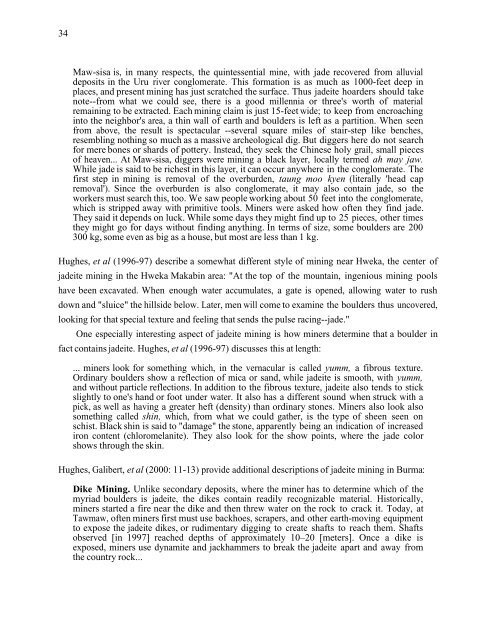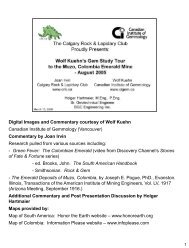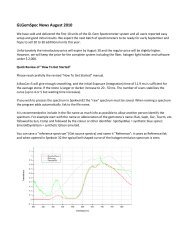JADEITE - Canadian Institute of Gemmology
JADEITE - Canadian Institute of Gemmology
JADEITE - Canadian Institute of Gemmology
Create successful ePaper yourself
Turn your PDF publications into a flip-book with our unique Google optimized e-Paper software.
34<br />
Maw-sisa is, in many respects, the quintessential mine, with jade recovered from alluvial<br />
deposits in the Uru river conglomerate. This formation is as much as 1000-feet deep in<br />
places, and present mining has just scratched the surface. Thus jadeite hoarders should take<br />
note--from what we could see, there is a good millennia or three's worth <strong>of</strong> material<br />
remaining to be extracted. Each mining claim is just 15-feet wide; to keep from encroaching<br />
into the neighbor's area, a thin wall <strong>of</strong> earth and boulders is left as a partition. When seen<br />
from above, the result is spectacular --several square miles <strong>of</strong> stair-step like benches,<br />
resembling nothing so much as a massive archeological dig. But diggers here do not search<br />
for mere bones or shards <strong>of</strong> pottery. Instead, they seek the Chinese holy grail, small pieces<br />
<strong>of</strong> heaven... At Maw-sisa, diggers were mining a black layer, locally termed ah may jaw.<br />
While jade is said to be richest in this layer, it can occur anywhere in the conglomerate. The<br />
first step in mining is removal <strong>of</strong> the overburden, taung moo kyen (literally 'head cap<br />
removal'). Since the overburden is also conglomerate, it may also contain jade, so the<br />
workers must search this, too. We saw people working about 50 feet into the conglomerate,<br />
which is stripped away with primitive tools. Miners were asked how <strong>of</strong>ten they find jade.<br />
They said it depends on luck. While some days they might find up to 25 pieces, other times<br />
they might go for days without finding anything. In terms <strong>of</strong> size, some boulders are 200<br />
300 kg, some even as big as a house, but most are less than 1 kg.<br />
Hughes, et al (1996-97) describe a somewhat different style <strong>of</strong> mining near Hweka, the center <strong>of</strong><br />
jadeite mining in the Hweka Makabin area: "At the top <strong>of</strong> the mountain, ingenious mining pools<br />
have been excavated. When enough water accumulates, a gate is opened, allowing water to rush<br />
down and "sluice" the hillside below. Later, men will come to examine the boulders thus uncovered,<br />
looking for that special texture and feeling that sends the pulse racing--jade."<br />
One especially interesting aspect <strong>of</strong> jadeite mining is how miners determine that a boulder in<br />
fact contains jadeite. Hughes, et al (1996-97) discusses this at length:<br />
... miners look for something which, in the vernacular is called yumm, a fibrous texture.<br />
Ordinary boulders show a reflection <strong>of</strong> mica or sand, while jadeite is smooth, with yumm,<br />
and without particle reflections. In addition to the fibrous texture, jadeite also tends to stick<br />
slightly to one's hand or foot under water. It also has a different sound when struck with a<br />
pick, as well as having a greater heft (density) than ordinary stones. Miners also look also<br />
something called shin, which, from what we could gather, is the type <strong>of</strong> sheen seen on<br />
schist. Black shin is said to "damage" the stone, apparently being an indication <strong>of</strong> increased<br />
iron content (chloromelanite). They also look for the show points, where the jade color<br />
shows through the skin.<br />
Hughes, Galibert, et al (2000: 11-13) provide additional descriptions <strong>of</strong> jadeite mining in Burma:<br />
Dike Mining. Unlike secondary deposits, where the miner has to determine which <strong>of</strong> the<br />
myriad boulders is jadeite, the dikes contain readily recognizable material. Historically,<br />
miners started a fire near the dike and then threw water on the rock to crack it. Today, at<br />
Tawmaw, <strong>of</strong>ten miners first must use backhoes, scrapers, and other earth-moving equipment<br />
to expose the jadeite dikes, or rudimentary digging to create shafts to reach them. Shafts<br />
observed [in 1997] reached depths <strong>of</strong> approximately 10–20 [meters]. Once a dike is<br />
exposed, miners use dynamite and jackhammers to break the jadeite apart and away from<br />
the country rock...









